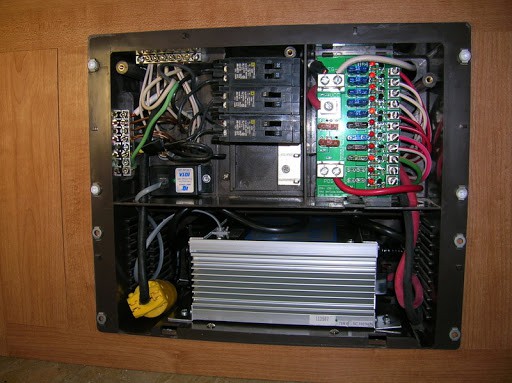Last Updated on April 11, 2022 by Ted Mosby
The world is dominated by technology, and we all love using tech gadgets. Take the example of your phone. You charge its battery to full, which means now you don’t have to worry about phone battery for hours and can enjoy your outdoor time.
However, as the day wears out, your phone battery gradually starts decreasing, from 100% to 90%, 80%, then 70%, and so on until the battery level remains only 10%. Now your phone will start reminding you to charge its battery. You rush back home to charge your phone battery before it dies.
This is exactly the same case with your RV battery. You are relying on the battery because it is the primary source that stores power and then supplies it to your entire RV to make sure all the amenities and appliances run efficiently.
But what if your RV battery runs out of charge? You are in big trouble. Especially if you are dry camping or boondocking and have no other source, you will be likely going to spend hours without power until you find someone to jump your recreational vehicle.
This is where I encourage all the RVers to learn DIY. It is essential to familiarize yourself and gain knowledge about your RV battery system. If you have an RV, regardless of what model and type it is, you should know where the power converter in your RV, how to find it, what type of battery your RV has, how to monitor its charging levels, and how to maintain it is.
Both the RV battery and converter work in tandem in order to supply voltages like DC to AC and vice versa. Below, I will outline everything related to your RV converter and battery that every RVer should know.
Where is the Power Converter In a Travel Trailer?
Converters are a crucial part of an RV, and they don’t usually come with most RVs. If your RV doesn’t have one, you will have to buy one. They are capable of powering up refrigerators, thermostats, lights, vent fans, etc.
If you are considering buying an RV converter but wondering about the price, you should know that they aren’t much costly, and you can get one for just $150 or $200.
You will have the option to get either the deck mount RV converter or distribution panel RV converter. However, when buying a distribution panel, you should consider its size bulky and large. This also means they function seamlessly and keep things running when the first one has been damaged.
Camping Gear SALE!
We have teamed up with Ape Survival to give you a huge 25% off EVERYTHING on their store! They have camping gear, hiking gear, survival gear and much more, all at 25% off when you click the link below.
SHOP NOWMoreover, distribution panel converters are generally installed on the wall. They feature fuses and circuit breakers, making them convenient.
A deck mount RV converter, on the other hand, doesn’t need to get installed into the wall and has a small size. They can be placed under a passenger seat, hatch compartment, at the back of the cabinet, or any other space convenient for you to access.
Where is the Power Converter in my RV?
However, if your RV is equipped with a pre-installed converter, but you cannot find the travel trailer power converter locations, here are the common RV power converter locations where you should look,
- The most common Power Converter location in travel trailers, where you can find it, is the area near the breaker and fuses. You should look under or beside the fuses box.
- The second common power converter location in RV is the compartment next to the batteries if it is not there.
- Another power converter location where you can look is under the kitchen cabinet. You can locate it by pulling a drawer – of course, if it is there.
If you have checked all these locations to find the power converter location but have no luck, you should turn on all the 12V lights and some appliances, helping you track the power converter location of your travel trailer.
Where is the RV Battery Located?
Finding your RV battery location varies depending on your RV type and model. So, it can be found in multiple locations. Generally, an RV battery location can be found in the exterior compartment, interior floor compartment, retractable entryway, or the engine compartment.
Remember, RV batteries aren’t similar to a classic AA battery in shape. They are rectangular or square-shaped and thick. The batteries are stored in the RV bank location, which can hold multiple packs of batteries. In simple words, if you want to get 12V power but your battery is 6V, you will have to add two 6V batteries to the battery bank.
While using a battery bank, you are required to use a jumper wire to link the batteries. Linking two batteries is a DIY process and doesn’t take much of your time. However, if it is your first time linking the batteries, you have to touch the first battery’s positive to the second battery’s negative terminal.
So, what are the battery system types?
Types of RV Battery System
Are you wondering what this 6V and 12V stuff are?
Most travel trailers use a 12V DC power system to generate electricity, which means the converter and batteries are both running on 12V. Moreover, an RV may also come with a 12V power system, which is not unusual. If you also have an RV with a 120V system, you can charge the batteries with both AC and DC.
Camping Gear SALE!
We have teamed up with Ape Survival to give you a huge 25% off EVERYTHING on their store! They have camping gear, hiking gear, survival gear and much more, all at 25% off when you click the link below.
SHOP NOWThis power system is capable of powering appliances, such as hairdryers, coffeemakers, and microwaves. But these appliances are luxuries, which is a bonus but not necessary. So, what if your RV comes with a 12V power system? Well, you will still get enough power that can run most of the items of your daily use, including TV, smartphone chargers, lights, furnace, laptops, etc.
However, before running these things on your 12V power system, you should make sure that they are also 12V because your 12V battery cannot run these items.
How to Check Your RV Battery?
Unlike your phone battery, which is much simple to use and analyze the charge percentage, the RV battery is complicated. More realistically, you will not get much information from your RV battery unless you have an RV battery monitor.
You can have it from any electrical store or RV supply store. However, before buying one, you should also make sure that the one you are going to buy is exclusively made for RVs. It will help you to get accurate RV battery information and charging levels.
Now, when you have your first RV battery monitor, it’s time to check your battery charging level. So, how can you do that?
Well, let’s say your RV is equipped with two 6V batteries that provide total of12V power. Now, when determining whether the battery needs to be charged or not, you will have to consider the voltage number. If the reading you get is 10.50, it means the battery is dead and has zero percent charge.
Here are some examples regarding RV charging that will help you to determine your RV battery levels,
- When the voltage reading is 11.75V: The battery level is 25%.
- When the voltage reading is 12.20: The battery level is 50%.
- When the voltage reading is 12.55: The battery level is 75%.
- When the voltage level is 12.80: The battery is fully charged.
How to Charge RV Batteries?
So, now you have learned how you can use the RV battery monitor to determine the battery charging level. But, what if your battery drops below 50%? How can you charge the battery?
Finally, this is where you will have to turn to your RV converter. When considering charging your RV batteries, you will need an RV converter and an electric outlet. Charging your RV batteries through the RV converter means you are swapping the grid power to the appropriate voltage level, and now the AC power will be transformed to 12V DC power.
Now, give some time to let the battery charge to 100%, and as soon as it reaches its full capacity, stop charging it.
Useful Tips for RV Batteries
Although even after taking so much care of your RV batteries, it doesn’t mean that they will last forever. However, through proper maintenance, you can extend their lifespan. Here are some useful tips,
- Make sure to keep your RV batteries at a suitable temperature (not too hot, not too cold) to prevent overheating. This is because they have hydrogen gas, which is extremely flammable and dangerous.
- Occasionally, top off the battery electrolytes. Electrolytes are a combination of sulfuric acid and water, which will decrease naturally over time.
- When linking two batteries in a battery bank, make sure to clean both positive and negative terminals.
- If your batteries are not performing well and are considering buying new ones, make sure to get a pair of batteries.
So, what are the components of an RV converter?
Components of RV Power Converter
Regardless of whether you have a distribution panel RV power converter or a deck mount RV power converter, they both come with almost components. As an RVer, you should know these components that will help you when you want to reset or troubleshoot it.
1. Power Inverter
RV power converter’s most crucial component is its power inverter, which is intended to transform AC power to DC power and vice versa to run batteries smoothly. The best manufacturers of power inverters are Pure Sine and Magnum. However, Pure Sine models are a bit expensive.
2. Resistors
In an RV power converter, you can locate the resistors beyond your RV converter, and to access it, you’ll have to go through the circuit board. They should be 12V DC, which makes them compatible with the entire battery system.
3. Circuit Board
The Circuit board of an RV power converter might be familiar to you if you have ever reset the power before. If you want to access the RV power inverter, you will have to go through the circuit board.
4. Fan
Like any other electrical component with a fan, the RV power converter also has it. Its only purpose is to keep the temperature normal to prevent it from overheating.
Wrapping Up
As an RVer, making yourself familiar with your RV electrical system is crucial, so you can fix minor issues by DIY. It is especially useful if you often travel off-road or dry camp, where you have no facilities.
Above I have discussed RV batteries and the RV power converter location. You can also read my previous articles to know more about your RV electrical system.
FAQ
No, most of the RVs and travel trailers don’t have a built-in power converter. If you cannot find a power converter location in your travel trailer, it means it doesn’t have one.Do all the RVs come equipped with a power converter?
You can buy an RV power converter for your RV, and there are two types of them. One is a distribution panel RV converter, and the other is a mounting deck power converter. Both have the same components. However, distribution panel RV converters are large in size than deck mount power converters.What are the types of RV power converter?
Table of Contents


